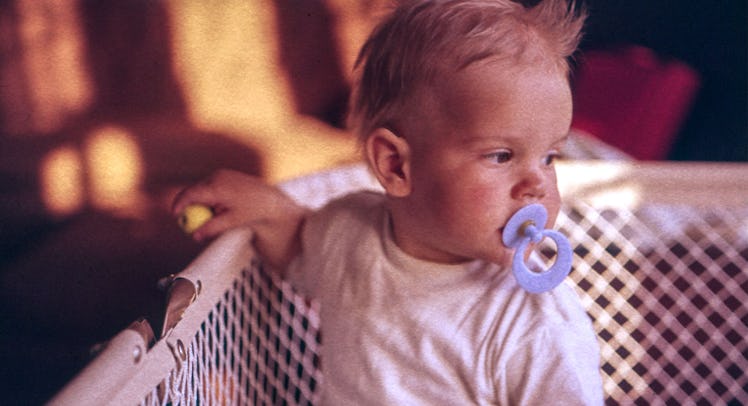6 Myths About How Pacifiers Work Parents Should Ignore
Parents need to clean their pacifiers and try not to worry about a paci damaging their children's teeth until they are about 4-years-old.

Pacifiers are nearly universally accepted as a tool for infant appeasement and comfort. As such, the pacifier is a ubiquitous symbol of early childhood. The good ol’ binky adorns baby shower and birth announcements, it’s the constant companion of character’s from Lisa Simpson to the Boss Baby. For the first year of a kid’s life, most strangers would be lucky to see a baby’s mouth behind that constantly pulsating plastic plug.
But because pacifiers are so widely accepted — and rightly so considering they help babies self-soothe and decrease the risk of SIDS — their more mythological properties are also often accepted as fact. But the truth is that the proper use of pacifiers requires a bit more thought and a bit less folk wisdom.
Pacifier Myth #1: The 5 Second Rule Applies to Pacifiers Too
It’s important to note that pacifiers can and do get dirty. It only takes a moment for a pathogen lingering on the ground to attach itself to the moist plastic of a sucsuc, ready to infect a kid.
That said, some parents may be of the mindset that a few germs can only help improve the kid’s immune system. But while exposure to limited germs of daily life is a fine thing, there’s much more that has been in contact with the ground that can be incredibly harmful to a kid. That’s particularly true in areas where pesticides and dog poop may be common.
RELATED: The Pros And Cons of Using A Pacifier With Your Baby
Some parents believe they can make an end run around the poop and pesticide problem by “washing” the pacifier with a quick swish in their own mouth before handing it back to the baby. This is a terrible idea and could pass to the kid anything from herpes virus, to colds, to the germs that cause cavities.
Pacifier Myth #2: Pacifiers Should be Tossed the Second They’re Dropped
There’s a television commercial featuring a hapless mom who is continually throwing out and ordering new pacifiers after they’ve hit the ground. This is completely unnecessary and wasteful.
A pacifier that has come in contact with the ground can easily be washed. If a parent has a spare, the dirty paci can be brought home and cleaned in the dishwasher, or in warm soapy water. If there is not a spare pacifier on hand, and parents are close to a faucet, rinsing the pacifier under warm water will suffice.
Pacifier Myth #3: Pacifiers Always Cause Dental Trouble
Pacifiers do not inherently cause dental issues. In fact, pacifier use up to toddlerhood will be unlikely to affect a child’s teeth in any way that will require corrective methods like braces or other orthodontics.
That said, a child that continuously uses and actively sucks on a pacifier past the age of 4 (when the adult teeth start coming in) may run the risk of their mouth growing around their pacifier. This can cause a pronounced arch in the front teeth.
ALSO: How to Introduce a Baby to a Pacifier
Still, malformed teeth due to pacifier use will not be a problem for most babies and toddlers. If parents are truly concerned they can have a dentist keep track of their child’s jaw and facial development if pacifier use doesn’t diminish after the age of 4.
Pacifier Myth #4: Pacifiers Should be Introduced at Birth
While pacifier use can help children, they are by no means necessary. The strong infant suckling instinct is better used to firmly establish breastfeeding in the first few weeks. Only after it is established should a child be given a pacifier during sleep of for soothing purposes.
Without a pacifier, some babies will find comfort in sucking their thumb or fingers. Thumb sucking is completely natural for children. They even do it in the womb. And as a kid grows and develops the need to use both hands to play, it can become easier for them to break a thumb sucking habit than it is to let go of a trusted pacifier.
Pacifier Myth #5: Dip Pacifiers in Honey or Alcohol to Increase the Calming Effect
The practice of dipping pacifiers in honey, sugar water or alcohol to increase the soothing effects is terribly problematic. Sugar water, for instance, can lead to cavities and decay in baby teeth, as well as adding unneeded calories to a baby’s daily intake. Honey is dangerous because it carries a risk of botulism and death, and early alcohol exposure can lead to long-term health effects far into adulthood.
It’s much better to leave a pacifier nice and clean. It will work its own soothing magic.
Pacifier Myth #6: Parents Should Shame or Bribe Toddlers Into Giving Up Their Pacifier
Many children, if left to their own devices, will eventually give up their pacifier without the need for special ceremonies, bribing or shaming from parents. This distancing from a pacifier will often occur around preschool as they begin to see peers that do not use pacifiers and experience peer pressure.
That’s a far more healthy transition than being forced or cajoled into giving up a pacifier. Additionally, the stress of being forced to relinquish a pacifier can backfire, driving a child to want to use their pacifier even more.